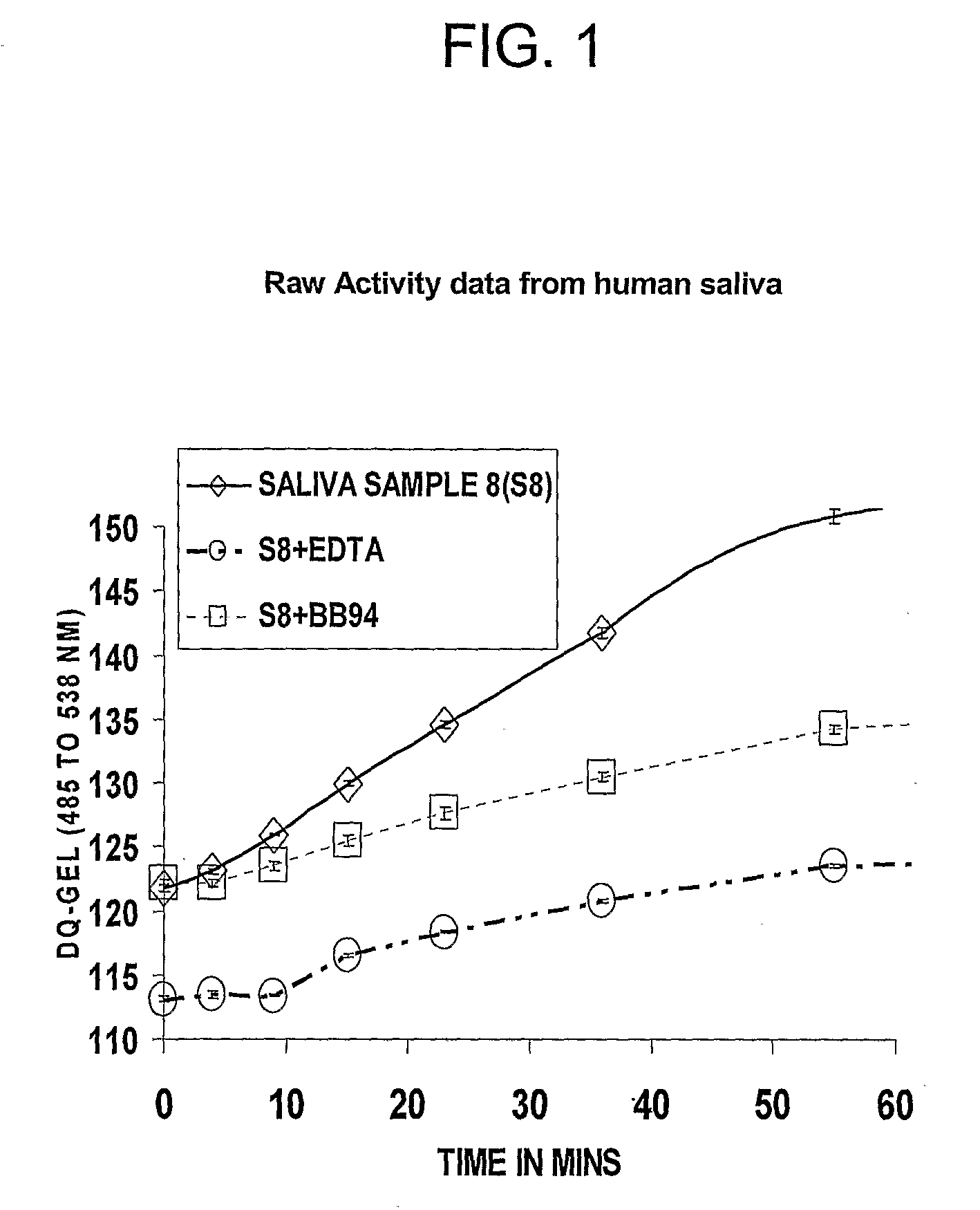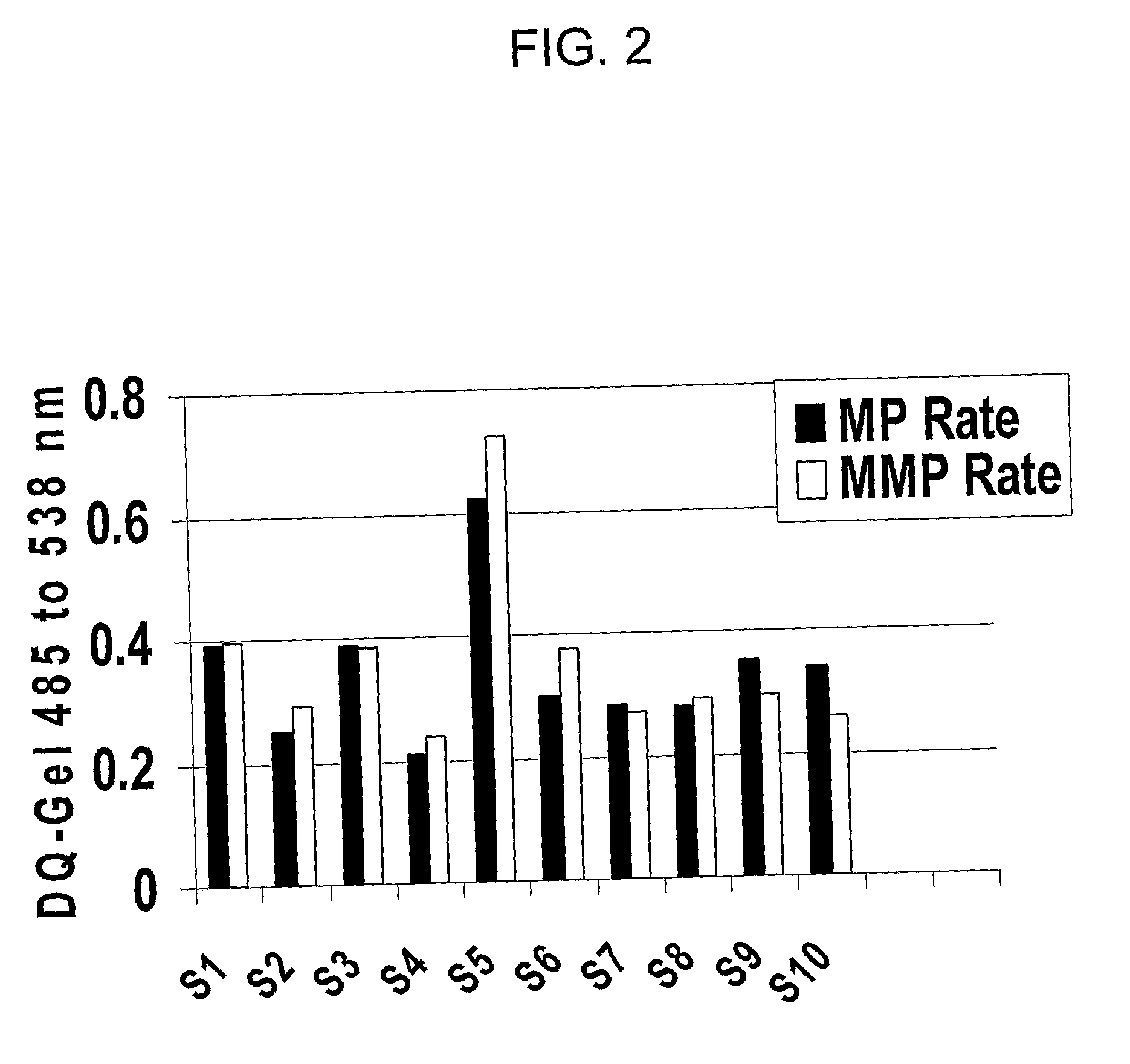Salivary Protease Assays for Identifying Increased Risk of Preterm Delivery Induced by Premature Rupture of Fetal Membranes
a protease and fetal membrane technology, applied in the direction of material analysis, biochemistry apparatus and processes, instruments, etc., can solve the problems of increasing the risk of premature delivery, increasing the risk of premature delivery, and increasing the risk of premature delivery , to achieve the effect of increasing the risk of preterm delivery, increasing the risk of premature delivery, and increasing the risk of prom
- Summary
- Abstract
- Description
- Claims
- Application Information
AI Technical Summary
Benefits of technology
Problems solved by technology
Method used
Image
Examples
example 1
Materials and Methods:
[0028]Human saliva collection: Saliva samples (˜2 ml) were collected from healthy volunteers using a commercially-available Salivette™ T device (Sarstedt, Newton, N.C., USA). Samples were collected after subjects had fasted for at least one hour. Subjects were instructed to rinse their mouths with water before chewing the Salivette wad for about 1 minute so as to saturate it with oral secretions, principally saliva. The samples were either used fresh or stored at −20° C., a process demonstrated not to affect activity.
[0029]Zymography: 20 μl of each saliva sample was mixed with 5 μl of a sample buffer containing 250 mM Tris pH 6.8, 25% glycerol, 10% (w / v) SDS, 0.01% bromophenol blue and loaded onto 10% SDS-PAGE gels containing 0.25% porcine gelatin (Sigma). Molecular weight markers (Biowhittaker Molecular Applications, Rockland, Me., USA) and a positive control sample of conditioned medium from the human fibrosarcoma cell line HT-1080 were...
example 2
Salivary Protease Activity in Human Pregnancy
Materials and Methods
[0040]Saliva samples were assayed for MMP activity from women in the second trimester of pregnancy, term (active labor and postpartum) and also from women who had PPROM and had spontaneous preterm deliveries. All saliva samples collected from pregnant and non-pregnant women exhibited proteolytic activity, predominantly MMP activity under the conditions for assay. Samples were analyzed using the DQ-Gelatin based MMP activity assay (see Example 1).
Results:
[0041]Saliva samples collected during pregnancy exhibited MP activity including MMP activity, defined as the proteolytic activity inhibitable by BB94. As in the saliva samples from non-pregnant individuals (see FIG. 2), the MMP activity constitutes most of the MP activity detected using this assay. The BB-94 inhibitable activity may also include some ADAMs activities, since this broad-spectrum MMPI has been shown to also inhibit the activities of at least some of the A...
example 3
Solid Phase Immunoassay for MMP Protein Concentration in Saliva
Materials and Methods:
[0044]Multiple bead assays are solid phase sandwich immunoassays, which are designed to be analyzed with a Luminex instrument. This technology is based on advances in microsphere technology and has led to the development of flow cytometric assays which allow the simultaneous detection of up to 100 analytes in a single microtiter well. The MMP assay, which was utilized in this study, is designed in a conventional capture sandwich immunoassay format. MMP specific antibodies are covalently coupled to color coded 5.6 μm beads. The antibody-coupled beads (R&D System, Minneapolis, Minn.) were incubated with known (standards; a broad range 8-point standard curve covering the expected range of concentrations were used) and unknown (saliva sample) amounts of MMP. After a series of brief washes to remove unbound protein, a biotinylated detection antibody specific for a different epitope on the MMP were added ...
PUM
| Property | Measurement | Unit |
|---|---|---|
| pH | aaaaa | aaaaa |
| pH | aaaaa | aaaaa |
| pH | aaaaa | aaaaa |
Abstract
Description
Claims
Application Information
 Login to View More
Login to View More - R&D
- Intellectual Property
- Life Sciences
- Materials
- Tech Scout
- Unparalleled Data Quality
- Higher Quality Content
- 60% Fewer Hallucinations
Browse by: Latest US Patents, China's latest patents, Technical Efficacy Thesaurus, Application Domain, Technology Topic, Popular Technical Reports.
© 2025 PatSnap. All rights reserved.Legal|Privacy policy|Modern Slavery Act Transparency Statement|Sitemap|About US| Contact US: help@patsnap.com



